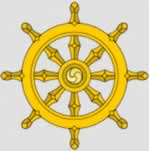DUKKHA IN DEPTH
The pages so far are an introduction to panoramic sensing, and how it neutralises wanting.
The following sections are intended only for people with a deeper interest in Buddhism and the origins and development of the word Dukkha.
I hope you will enjoy demystifying Buddhism.
Historical Development of the Wheel
First, there is a section on the origins and history of the wheel, the invention of steel for the rims and hubs, the necessity for roads, and the early development of the word Dukkha.History of Rotary Motion
Development of The Wheel
Development of the Meanings of Dukkha and Sukkha
The Texts and Translations
Buddha's central teachings are the Four Noble Truths. The Mahāsatipaṭṭhāna is the most detailed version of the Four Noble Truths in the Pali Cannon. All the translations in all available Western European languages were researched. My ideas are based on this text.K.E.Neumann's pioneering work gave us the first translations of the entire Pali Cannon into German in 1929. However he paraphrased the Mahāsatipaṭṭhāna's Second and Third Truths. (Reducing circa 2,480 words to 370 words.) His work was further translated in 1962, and became an English bestseller.
Therefore the basis of modern Buddhist thought was developed before any full translations of the Four Truths were available.
The Four Noble Truths
The first three Truths discuss Dukkha, its beginnings, and endings.The Fourth Truth is the Eightfold Path. This is a list of eight instructions. These instructions appear to have been generally well understood and accurately transmitted through the ages.
However, for example in the sixth instruction, there is an vast divergence in translation of a central word,. This demonstrates vividly how variations would have occurred in preliterate times.
In all translations of the Mahāsatipaṭṭhāna, the first of the eight instructions is specifically: "The Right Understanding of Dukkha". This understanding is central to Buddhism.
Right Understanding does not refer to the right understanding of the Sun and Moon, or genetics, or general philosophy, or anything else except Dukkha.
Dukkha and The First Noble Truth
In Buddha's time Dukkha described when the turning of a wheel was problematic, when it was not running smoothly.Buddha had an enormous following during his life time. This demonstrates that Buddha's original truths were simple, and they could be understood by the common person, not only by philosophers after years of study and meditation.
Buddha's First Noble Truth, is explained in detail.
A sub-page explains The Five Aggregates. This was one of Buddha's new ideas. The words for such phenomena didn't exist in those times.
Buddhists of faith maintain The Transmission of the Teachings was accurate and the texts record Buddha's spoken words. However it is doubtful that anyone had a photographic memory for his words. Amd the sermons were written down more than 400 years after he spoke.
The crucial point is that the texts of the Mahāsatipaṭṭhāna's First Noble Truth, and the Second and Third Noble Truths are incongruous.
In the First Truth "What is Dukkha?", there are only two small sections on the Aggregates. The First Truth emphasises that Dukkha consists of various forms of common worldly suffering: illness, old age, death, sorrow, lamentation, pain, grief and distress, and the "suffering" of not getting what you want, and getting what you don't want. The First Truth is concerned with the obvious bitter suffering involved in displeasure.
The Second and Third Truths are in depth discussions of the Aggregates in relation to the senses. They are pure cognitive psychology, with a touch of philosophy, and there is absolutely no mention of any examples of worldly suffering. By contrast, the Second and Third Truths discuss the "suffering" involved in pleasure and delight – this is far more challenging subject.
Whereas the First is concerned with the suffering of pain and displeasure, the Second and Third discuss the suffering inherent in pleasure and delight.
It is utterly astounding that this inconsitency has, to my knowledge, never been examined by Buddhist truth seekers.
The simple truths have been obscured over with the years. This has confused countless generations of Buddhists.
This confusion is exposed and hopefully clarified in Suffering: The Traditional First Noble Truth.
 The modern development of the symbol for Dukkha, the wheel of life, is The Buddhist Dharmachakra. This takes the modern Buddhist development of the meaning of Dukkha to its symbolic conclusion – completely obscuring the original idea.
The modern development of the symbol for Dukkha, the wheel of life, is The Buddhist Dharmachakra. This takes the modern Buddhist development of the meaning of Dukkha to its symbolic conclusion – completely obscuring the original idea.
All pages in this section
The HistoryThe History of Rotary Motion
Development of The Wheel
Development of the Meanings of Dukkha and Sukkha
The Teaching
Buddha's First Noble Truth
The Five Aggregates
The Transmission of the Teachings
Suffering: The Traditional First Truth
The Buddhist Dharmachakra
The Fourth Truth – The Eightfold Path
The Mahāsatipaṭṭhāna – References
Back to Chapter Four : Buddhism and Wheels
Back to THE PANORAMA SENSES Priority Pages